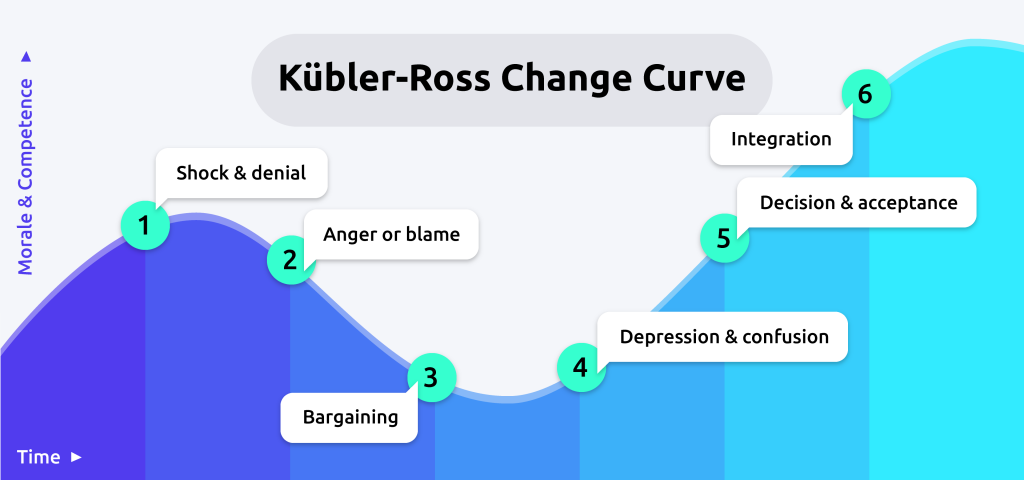The Kübler-Ross Change Curve and Internal Communication: How to Communicate Effectively During Organizational Change
Estimated reading time: 10 minutes
In our change management blog series’s latest installment, we explained how employees do not always contribute to change. In fact, in some cases, they even oppose the change. But in most cases, refusal to change is futile, as change is the number one certainty in life. It can be a catalyst for the growth of individuals and organizations – so why the resistance? The answer may lie in the Kübler-Ross Change Curve, which describes the internal emotional journey that individuals typically experience when dealing with change and transition. In this curve, there are a couple of key stages to consider to help your employees experience, understand, and fully accept the change. Simple and clear communication is crucial to make this happen. Read on to learn how to navigate your employees through organizational change with internal communication and the Kübler-Ross Change Curve.
Table of contents
- What is the Kübler-Ross Change Curve?
- Importance of the Kübler-Ross Change curve
- Internal Communication and the Stages of the Kübler-Ross Change Curve
- Stage 1: Shock and denial
- Internal communication during this stage
- Stage 2: Anger or blame
- Internal communication during this stage
- Stage 3: Bargaining
- Internal communication during this stage
- Stage 4: Depression and confusion
- Internal communication during this stage
- Stage 5: Decision and acceptance
- Internal communication during this stage
- Stage 6: Integration
- Internal communication during this stage
What is the Kübler-Ross Change Curve?
The Kübler-Ross Change Curve is based on the work of Elisabeth Kübler-Ross, who outlined the stages of emotions experienced by a person in relation to loss, originally called the Five Stages of Grief Model. The original model has since been extended and applied to situations relating to change, as change usually can result in some type of loss, however minor.
The Kübler-Ross Change Curve has since come to consist of the stages described below. Thus, the Kübler-Ross Change Curve is also applicable in the business world when organizations and employees deal with major or significant changes. This can be relative: a small change may still be significant for individual employees who will process the change through their own internal emotional journey.
The Change Curve will help leaders and managers better empathize with their employees. It will help them understand how people emotionally feel when they are going through a change and shed light on where employees are in accepting and adapting to the change at hand. This model is different from the others in the sense that it is completely employee-oriented.
Importance of the Kübler-Ross Change curve
The resistance to change we described in our previous change management blog dictates a choice to hold on to the way things used to be done, causing a disruption in the acceptance and integration of the change. However, the easier it is for employees to move along on their change acceptance journey, the sooner an organization will move towards success and successful change. If employees persist in their old ways, the time, effort, and financial resources invested in the change will likely go to waste.
As time goes on and employees go through their internal emotional journey, their morale, competence, and motivation will waver. Thus, understanding how and why employees will resist a change will be useful—Recognizing the stages of the Kübler-Ross Change Curve and knowing how to act accordingly to help employees adapt and change can, in turn, help your organization move ahead and help your organization reap the benefits of your organizational change.
Internal Communication and the Stages of the Kübler-Ross Change Curve

Stage 1: Shock and denial
The initial ‘shock’ of being confronted with a change will result in defensive behavior. The shock is usually short-lived and a result of a lack of information, fear of the unknown, or uncertainty. It often causes people to go into ‘denial’ – they resist engaging with the change as if trying to prove that it is unreal or unnecessary. They may not be able to digest the fact that they will have to adapt to something new. Employees may cling to the past, moving forward as if nothing has changed. A dip in productivity is to be expected.
Internal communication during this stage
This stage demands simple and clear communication about why the change is necessary. Employees in this stage need information: they want to understand what is about to happen and why the change is being made. Do not overwhelm employees with information, but drip-feed small chunks of simple communications For example, in a face-to-face meeting first and later or as a reminder through several messages in an employee app or a dedicated page on SharePoint, that you can connect to your digital signage screens to make sure information reaches all employees.
The key question that employees will want an answer to is ‘what does this change mean for me?’. So, as well as explaining all the things that will change, make sure to tell your staff what will remain the same. If, for example, the office location, their team, or their dedicated workspace will stay the same, be sure to let them know not everything will change for them.
Stage 2: Anger or blame
In this stage, employees come to terms with the reality. As a result, they often begin to fear the future and uncertainties that the future holds (such as job insecurities). Some employees will take out the anger on themselves; some may direct it towards others. This is a natural reaction, and with time, it shall pass and make way for acceptance.
Internal communication during this stage
Be mindful of your message. Do not trash the past or the current situation – employees are trying to hold onto that as much as possible, and criticizing the current way of working will not help them accept the change. Do not start selling the benefits of the change at this point. Employees are still too busy working through the change itself. Carefully consider the impacts and objections that people may have.
Listen to your colleagues’ worries and provide (digital) spaces where people can share uncertainties and questions and can find answers to these questions. Think of a dedicated page on SharePoint or a channel in Microsoft Teams. Ensure employees know where to go for help. Provide maximum opportunities for communication between staff and key stakeholders for the change (sponsors, leaders and managers, decision-makers). A social feature in communication in a corporate app can be deployed to spark conversation. In this stage, it’s important that communication isn’t just top-down; employees should feel heard and organizations should be open for feedback and their employees’ feelings.

Stage 3: Bargaining
At this stage, employees might start bargaining with, for example, management to minimize compromising the old situation. They will only learn new skills or knowledge if they think it is important to do so. However, staff should be encouraged to take full advantage of training; to learn as much as possible for the change to be executed successfully.
Training must be done at a convenient time and conducive pace for all employees – rushing them into learning and adapting fast must be avoided. Employees need to test and explore what the change means, and they will do this more easily if they are helped, supported, and given enough time to do so. Productivity levels will be lowest at this stage as employees also try to learn new skills and knowledge.
Internal communication during this stage
Provide spaces where employees can make suggestions and allow plenty of discussions as this may bring some relief to those who are moving closer to acceptance. Ensure employees know when workshops and training are held. Send notifications to make sure employees do not forget to attend training. Publish small chunks of training via digital signage or screensavers to gently repeat new skills and knowledge and to keep employees in touch with changed processes or activities. Be quick to celebrate success, possibly by bringing in other parts of the organization that have already successfully been through their change journey.
Stage 4: Depression and confusion
Employees may have realized by now there is no way out of the change. The internal emotional journey to this point has been characterized by a drive to hold on to or revert to the current situation. The realization that efforts are failing to keep things the way they are will leave employees at their lowest point of morale, energy, and performance.
Internal communication during this stage
Active listening, effective support structures, and empathy are crucial for boosting morale and employee engagement and to help employees navigate through this stage of the Change Curve where negative feelings prevail. Promote and encourage networking across the organization and generate opportunities for employees to come together and share ideas, questions, and experiences. Clear communication and possibilities for networking become even more important when large parts of your workforce are working from home, isolated, and unable to easily share experiences and uncertainties.

Stage 5: Decision and acceptance
This is the stage you have been waiting for: employees will stop fighting the change, accept that it is happening, and resolve to face this ‘new future.’ They will realize the importance of the change and resign towards it. Some people may do this because of a lack of another option; others may genuinely view the change as positive. Overall productivity begins to improve.
Internal communication during this stage
Employees have come to terms with the fact that the change will happen, so communication should now revolve around the benefits of the change and what part employees or even individuals will play in the new situation. Leadership should engage employees in the change message and should be setting the right example. Share stories from change ambassadors and stakeholders. Communicate about the benefits of the change and show employees what you have achieved so far to help them further engage with the change.
Stage 6: Integration
Employees build aspirations towards the future and make positive advancements. People begin to engage in problem-solving behaviors. Employees will try out new approaches and eventually integrate them into their new way of working and being.
Internal communication during this stage
This is the stage where the change is embraced by most employees. Transparency about visible or future benefits of the change and celebration of success is important now. Show employees you know it wasn’t easy for them to make this change and recognize how well they have done up until now. Make employees feel seen and celebrated for all they have done to get this far.
It is good to keep in mind that the Kübler-Ross Change Curve does not necessarily describe a linear process. Employees can move through the stages in a random order, sometimes occupying different stages simultaneously and sometimes even returning to previous stages. Each stage can last for a different time period, and a person can get stuck in a particular stage and not move on from there if they are very deeply affected by the change. However, recognizing the stages and knowing how to act upon employees’ behavior can help achieve a successful organizational change.
Your employees’ internal emotional journey is not the only thing that can get in the way of your organizational change. Are you curious about what other forces push and pull at your organization? Download our 4 forces that make or break your organizational change infographic to find out! Or do you want to know more about change management and discuss how internal communication can streamline your organizational change? Get in touch with our consultants, they will be happy to advise you!

What communication channels are most effective during change management?
We recommend a multichannel communication strategy using tools such as:
Digital signage for broad awareness,
Desktop notifications for urgent updates,
Mobile apps for remote staff,
Screensavers for subtle reinforcement,
And feedback tools to maintain two-way communication.
This ensures messages are seen, understood, and reinforced across all employee groups, regardless of location or role.
What are some recommended communication strategies for each stage of the Change Curve?
The article outlines tailored approaches for each phase:
Denial: Use factual, clear messages to explain the change and its necessity.
Anger: Allow space for feedback and listen empathetically.
Bargaining: Provide channels for dialogue and involvement in shaping the change.
Depression: Offer reassurance, resources, and highlight support structures.
Acceptance: Celebrate progress, share success stories, and encourage forward-looking engagement.
Each approach helps reduce uncertainty and builds emotional resilience.
How can internal communication help employees move through the stages of change more effectively?
Internal communication plays a critical role in guiding employees through change. The article emphasizes the need for timely, empathetic, and transparent communication. By aligning messages with the emotional needs of each phase—providing clarity during denial, acknowledgment during anger, support during bargaining and depression, and empowerment during acceptance—organizations can build trust, reduce resistance, and foster a smoother transition.
